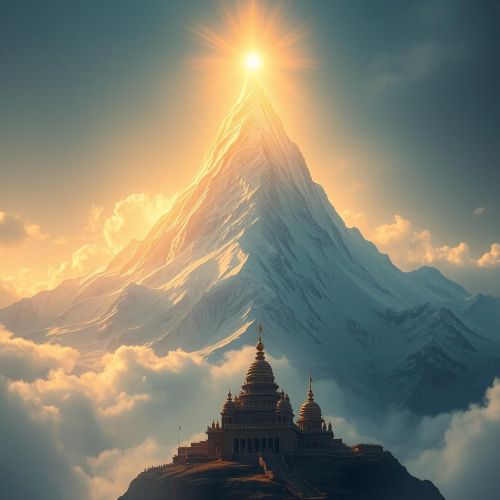Mount Aso and the God Who Tamed the Fire
Towering over the verdant landscapes of Kyushu in southern Japan, Mount Aso is the country’s largest active volcano — and one of the largest in the world. While scientists have unraveled much about its fiery geology, the people of ancient Japan had their own explanations for its rumblings. These tales, deeply rooted in Shinto belief and local folklore, offer a spiritual and mythological origin of Mount Aso that goes far beyond tectonic plates and magma chambers.
In these stories, the volcano is not merely a mountain; it is alive, divine, and filled with ancient power. Let’s explore how mythology explains the creation and significance of Mount Aso, and how it continues to shape local identity even today.
Takeiwatatsu-no-Mikoto: The God of Aso
The central figure in the mythology of Mount Aso is the Shinto deity Takeiwatatsu-no-Mikoto, often considered the divine founder of the Aso region. He is said to be a grandson of Emperor Jimmu, the legendary first emperor of Japan and a descendant of the sun goddess Amaterasu.
According to legend, Takeiwatatsu-no-Mikoto was sent from the east to tame the wild lands of Kyushu. Carrying with him a sacred plow, he was tasked with introducing agriculture, peace, and civilization to the people of the region. As he journeyed across the land, he chose the area around modern-day Mount Aso to establish his rule.
The divine plow symbolizes the transformation of a wild, volcanic land into one that is fertile and life-giving — a clear metaphor for turning the chaos of fire and ash into the order of rice fields and harvests. In many tellings, Mount Aso’s smoking crater is seen as the god’s breath, a constant reminder of his presence and protection.
The Mountain That Refused to Be Bound
One of the most compelling and poetic myths surrounding Mount Aso involves Takeiwatatsu-no-Mikoto attempting to contain the volcanic fire within the mountain. The story goes that he placed a massive stone lid over the crater to suppress its fury and prevent the fire from spreading. However, the fire inside the mountain was too powerful, and eventually, the lid cracked — allowing smoke and ash to escape once again.
This myth provides a symbolic explanation for Mount Aso’s persistent activity. The volcano, despite divine intervention, could not be subdued — a reflection of the Japanese reverence for nature’s unstoppable forces. Even a god could not fully suppress the living fire of the earth.
The Divine Homeland: Aso Shrine
The mythology of Mount Aso is also enshrined — literally — at Aso Shrine, one of the oldest and most important Shinto shrines in Japan. Built over 2,000 years ago, it is dedicated to Takeiwatatsu-no-Mikoto and his descendants, who are believed to have ruled the Aso region and protected it from calamities.
Located within the massive Aso caldera, the shrine’s placement is symbolic: a sacred space nestled in the heart of a living volcano. Visitors often come here not only to pay respects but also to seek blessings for protection against natural disasters, especially volcanic eruptions.
The gods enshrined at Aso are believed to maintain harmony between humans and the mountain. In times of relative calm, it is said that the gods are pleased. But when the volcano stirs, it is interpreted as a sign that the natural balance has been disrupted, and rituals are performed to restore it.
A Mountain with a Heartbeat
For the people living in and around the Aso region, the volcano is more than a geological formation — it is a living deity. The mountain is often referred to in personal terms, almost as if it were a member of the community. Some local traditions teach that the volcano has moods and emotions, and that the rumblings and steam are expressions of its will.
Children are raised with these stories not as fantasies, but as cultural truths that instill a deep respect for the natural world. Farmers offer thanks to the mountain for its fertile soil, derived from centuries of volcanic ash. Elders remind younger generations that while science can predict eruptions, only reverence can preserve the sacred bond with the land.
Myth and Modernity: Mount Aso Today
Despite modern geological tools monitoring its activity, the mythological essence of Mount Aso remains strong. In fact, these ancient stories coexist with scientific understanding in a uniquely Japanese way. It is not uncommon for locals to consult both seismologists and priests when the mountain shows signs of waking.
Festivals held at Aso Shrine celebrate both seasonal change and the ongoing relationship between people and the divine mountain. Dancers, drummers, and priests re-enact the ancient stories, reminding attendees that Mount Aso is not just part of their landscape — it is part of their identity.
Conclusion: The Sacred Fire of Mount Aso
Mount Aso’s creation story is more than volcanic activity; it is a sacred narrative of divine purpose, celestial ancestry, and the complex dance between human beings and the forces of nature. While science tells us the “how,” mythology tells us the “why.” And in the myths of Takeiwatatsu-no-Mikoto and the smoking mountain, we find not just answers — but meaning.
Through these ancient tales, Mount Aso becomes more than a volcano — it becomes a living symbol of reverence, resilience, and relationship with the divine. And in that, it continues to inspire awe, even as it rumbles beneath our feet.
No posts were found.









